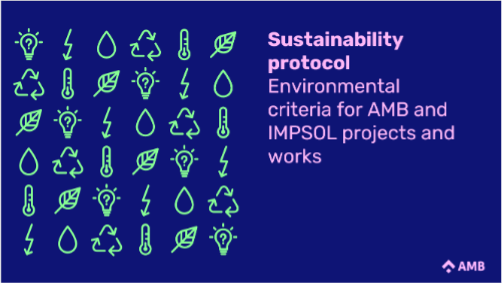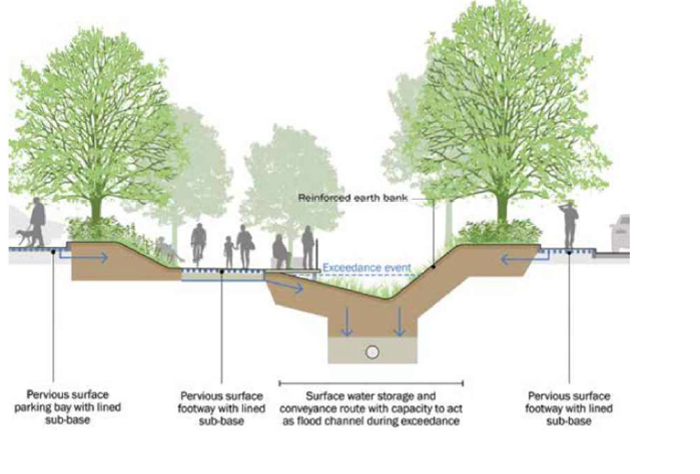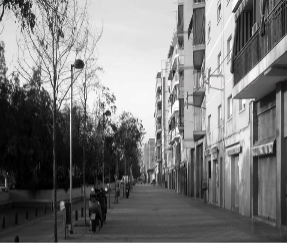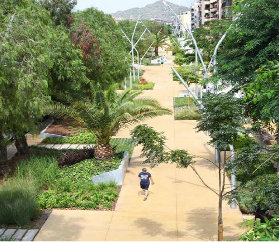Barcelona Metropolitan Area (AMB), Spain
Faced with increased droughts, heavier rainfall and more frequent flooding, the Metropolitan Area of Barcelona has developed a Sustainability Protocol that outlines mandatory criteria for urban development with a strong focus on water resilience. The Protocol’s criteria for water management aim to improve drainage and flood management while also promoting sustainable water use.

The Metropolitan Area of Barcelona comprises 36 municipalities and covers 636 km², of which 52% are green spaces. Located along Spain's northeastern coast and bordered by the Mediterranean Sea to the southeast, this region faces pressing climate challenges, including rising temperatures, water scarcity, increased flooding, and coastal erosion. Given these factors, a holistic and sustainable approach to water management is essential for the region's resilience and long-term well-being.
The Sustainability protocol

Established in 2019, the Sustainability protocol serves as a comprehensive guide for urban development, outlining 19 mandatory criteria across six key areas: cross-cutting analysis, energy, water, materials, health and comfort, and site sustainability. This protocol was created to fill the legislative gaps regarding climate change and applies to all building and urbanisation projects contracted by the Public Space Department of Barcelona Metropolitan Area (AMB) and the Metropolitan Institute of Land Development and Property Management (IMPSOL).
Focus Areas
The protocol centres around two main pillars:
Mitigation: focusing on reducing energy demand and consumption, reducing GHG emissions and promoting circularity.
Adaptation: focusing on reducing water consumption, promoting use of alternative water resources, managing runoff, boosting biodiversity, greening the city, reducing the heat island effect, and supporting sustainable mobility.
In response to the significant climate challenges it faces, including rising temperatures, water scarcity, increased flooding, and coastal erosion, the AMB region has implemented a comprehensive approach integrating proactive rainwater management with efficient water consumption strategies. In the region’s efforts to strengthen water resilience, this initiative aims not only to improve drainage and flood management but also to promote sustainable water use.
Proactive Rainwater Management
A key objective of the protocol is to facilitate rainwater’s return to aquifers, while improving drainage, and minimising runoff. This is achieved through Sustainable Urban Drainage Systems (SUDS), which differ from conventional drainage by promoting natural water cycles and infiltration.
Implementation
The protocol mandates the infiltration of 15 millimetres of rainwater in urbanisation projects and 10 millimetres in building exterior spaces, managing water volumes based on the 80th percentile of AMB’s annual average precipitation.

Source: Metropolitan Area of Barcelona. https://www.amb.cat/s/home.html
SUDS in practice: Salzereda promenade in Santa Coloma de Gramenet
A notable project completed three years ago involved a 500-meter-longwalkway designed to infiltrate rainwater without impermeable barriers. Before the intervention, the walkway suffered from water accumulation due to a lack of slope and elevated planters.
With the new infrastructure, water is directed to rain gardens with drainage trenches and infiltration wells, effectively channelling 90% of the walkway's water. The trenches, measuring 40 by 60 centimetres, lead the water to wells that are 4 meters deep and 2 meters in diameter, also acting as overflow systems that prevent flooding.
BEFORE: Accumulation of water due to poor drainage. AFTER: 90% rainwater infiltration


Source: Metropolitan Area of Barcelona. https://www.amb.cat/s/home.html
Limiting Water Use in Irrigated Areas
The AMB has developed efficient irrigation strategies, requiring buildings with roofs larger than 500m² to use rainwater. Potable water consumption limits are set at 400 l/m², with total consumption limited to 650 l/m².
An irrigation calculation tool determines water requirements based on the type of plantation, considering factors such as plant species, soil characteristics, irrigation method, and rain control systems. It calculates annual water consumption in litres/m² for every project, enabling more efficient irrigation planning and encouraging responsible water usage while minimising excessive practices. The table below illustrates this irrigation calculation tool.
| Identification | Very low consumption | Low Consumption | Medium Consumption | Grass | Warm Grass |
Surface (m²) | Surface (m²) | Surface (m²) | Surface (m²) | Surface (m²) | Surface (m²) |
| Type of Vegetation | Shrubs | Shrubs | Shrubs | Grass C3 | Grass C4 |
| Species Factor (ke) | 0.2 | 0.4 | 0.5 | 0.8 | 0.6 |
| Plant Density (kd) | Medium | Medium | Medium | Medium | Medium |
| Microclimate | Medium | Medium | Medium | Medium | Medium |
| Microclimate Factor (km) | 1 | 1 | 1 | 1 | 1 |
| Soil Texture | Loam-Sandy | Loam-Sandy | Loam-Sandy | Loam-Sandy | Loam-Sandy |
| Irrigation Type | Drip Irrigation | Drip Irrigation | Drip Irrigation | Sprinkler | Sprinkler |
| Irrigation Factor (r) | 0.9 | 0.9 | 0.9 | 0.7 | 0.7 |
| Irrigation Control | Yes | Yes | Yes | Yes | Yes |
| Annual Consumption (m³) | 64.00 | 192.00 | 336.00 | 853.71 | 576.00 |
Source: Metropolitan Area of Barcelona. https://www.amb.cat/s/home.html
Lessons Learned and Next Steps
The implementation of SUDS has underscored the need to integrate sustainable practices into urban planning. As Catalonia faces a predicted 10% reduction in rainfall by 2050, along with more intense precipitation events, efforts will focus on adapting to these changes by:
- Consolidating SUDS on pedestrian areas;
- Generalising road drainage;
- Monitoring SUDS for operational feedback;
- Involving all administrations in SUDS implementation;
- Aligning AMB irrigation limits with projects;
- Promoting low-water-consumption vegetation.
Transferability of the Protocol
The AMB has pioneered the introduction of mandatory local environmental criteria in public procurement in Spain, integrating resilience and urbanisation standards into the Sustainability Protocol, applied to 77 urbanisation projects, 8 new buildings, and 18 renovations.
As a supra-municipal entity encompassing 36 municipalities, the AMB's broader scale amplifies its impact. The Sustainability Protocol serves as a model for other administrations, gaining recognition through lectures, workshops, and collaborations with institutions such as the Catalan Government, the BEIS department of the UK, and cities like Singapore, Brazil, and Zagreb.
Barcelona Metropolitan Area Key Figures
- Population: 3.3 million inhabitants
Covenant Figures
- Signatory to the Covenant of Mayors since: March 2023
- Emission reduction ambitions:
- % GHG emissions reductions by 2030: 55%
- Carbon neutral by 2050
Current investment budget
The Public Space Department oversees Metropolitan Investment Plan projects in public spaces and facility buildings, completing over 400 initiatives with a €200M investment (2020-2023) and allocating €150M for 2025-2028.
